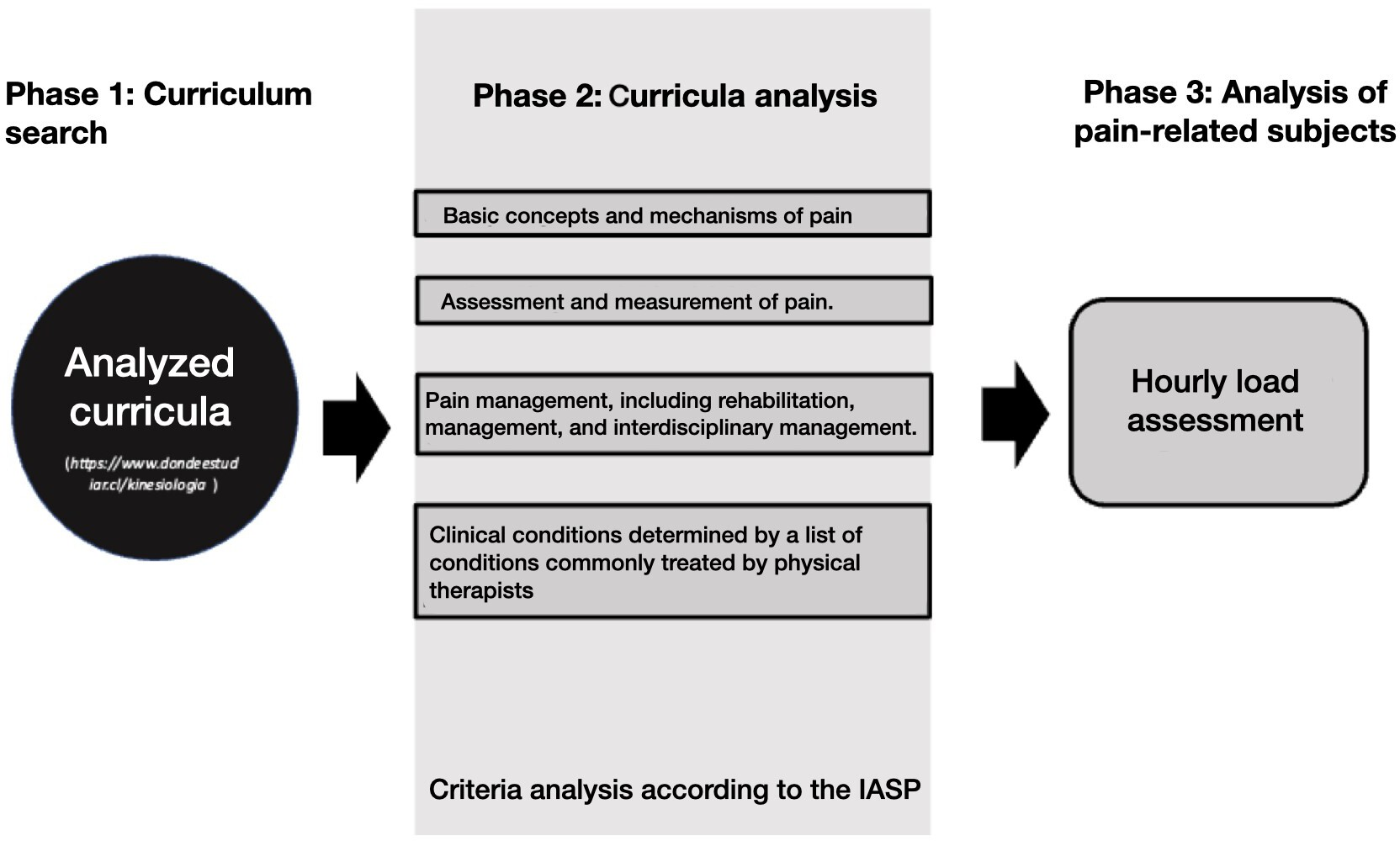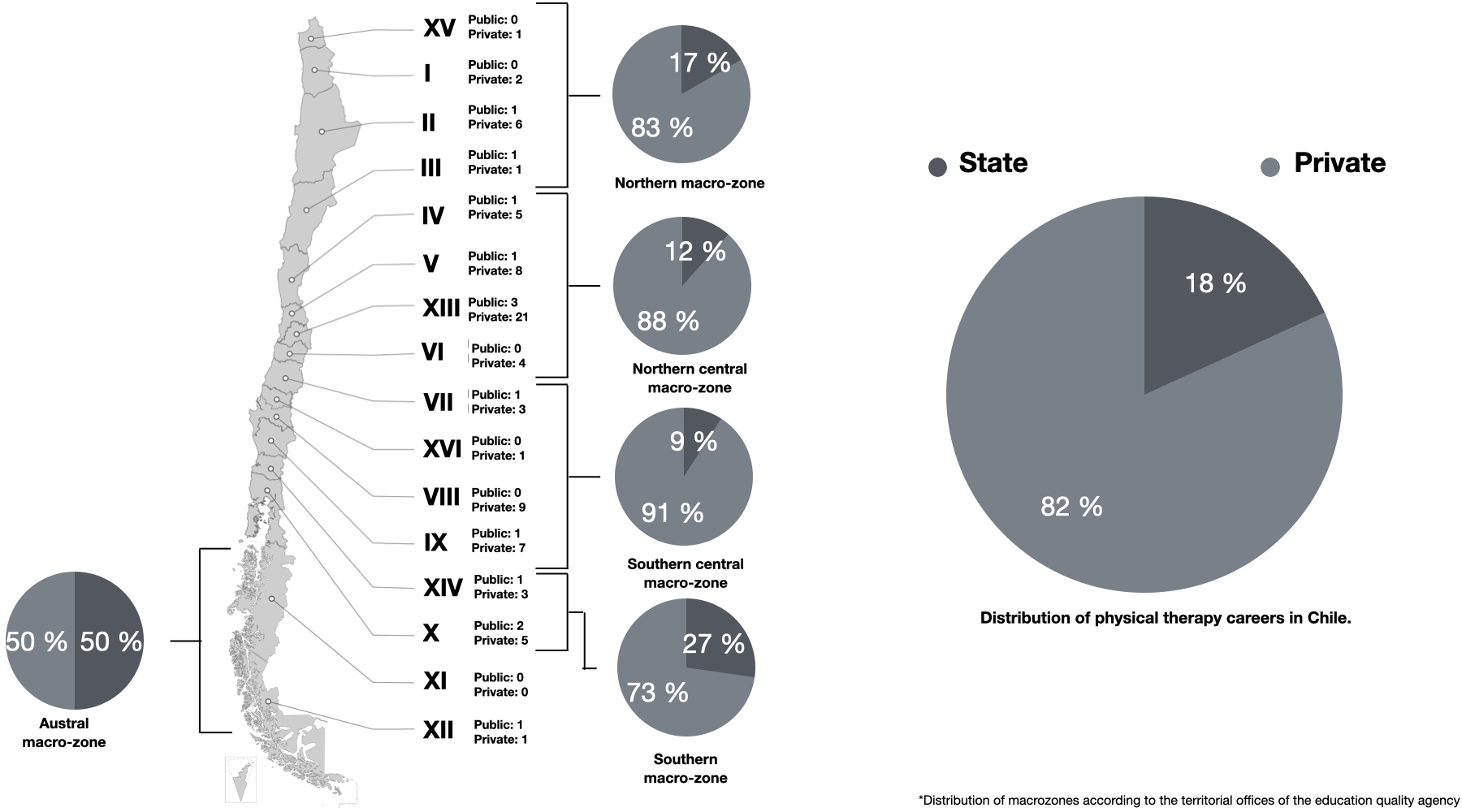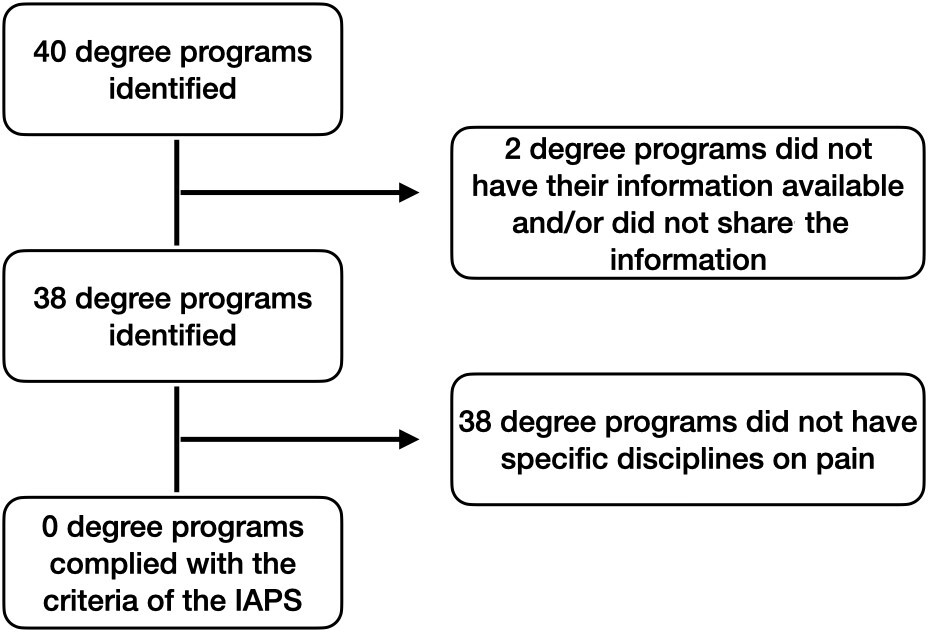Short communications
← vista completaPublished on December 11, 2023 | http://doi.org/10.5867/medwave.2023.11.2713
Education on pain disciplines in physical therapy in Chile: In need of change
Educación sobre las disciplinas del dolor en las carreras de kinesiología en Chile: necesidad de un cambio
Abstract
Pain is a major public health concern associated with emotional disorders and physical disability and generates increased sick leave and healthcare expenditures. However, despite its social impact and the high pain-related costs, the training of healthcare professionals, such as physical therapists, in pain management is insufficient, leading to an inadequate therapeutic approach. This study aimed to determine the existence of a specific program on pain within the curricula of physical therapy careers in accredited universities in Chile. Out of 40 physical therapy careers, we analyzed 38 curricula. None of them had a specific discipline on pain management in their curricula. Although there is no concrete definition of the best modality for pain education in undergraduate students, it has been shown that following the International Association for The Study of Pain curricula improves students' knowledge and awareness of pain management.
Main messages
- Despite the strong impact of pain on Chilean public health, there is a gap in the training of Chilean physiotherapists on pain management during their undergraduate studies.
- The study provides a unique perspective by analyzing physical therapy curricula in Chile, showing a lack of specific programs on pain.
- The impossibility of accessing detailed curricula descriptions makes it impossible to confirm whether pain content is integrated into other subjects.
- The lack of specialized training may have repercussions in the inadequate management of pain in the Chilean population by future professionals.
Introduction
Pain, defined by the International Association for The Study of Pain as an unpleasant sensory and emotional experience associated with actual or potential tissue damage [1], is considered a public health concern given its high prevalence and economic costs [2]. Epidemiological data show that it affects between 20 and 50% of the general population, making it the leading cause of disability worldwide [3]. Chronic non-oncologic pain is considered a public health problem, affecting 20 to 35% of the population worldwide, 19% of the European population, and 17% of the Spanish population [4]. In Chile, there are descriptive studies on the prevalence of chronic pain. In them, somatic pain has a prevalence of 65.6% and neuropathic pain 33%. Likewise, the etiology includes low back pain (22.1%), osteoarthritis (16.1%), and rheumatoid arthritis (8.8%) [5].
Chronic musculoskeletal pain arises daily, has a long duration, and, if insufficiently treated, impacts people’s quality of life, both emotionally and in their daily life activities. Considering its impact and high prevalence, the International Association for The Study of Pain has encouraged all physiotherapy and physical therapy programs to include in their curricula specific subjects to improve the knowledge and skills necessary for pain management as part of an interprofessional team (accessible at
In this regard, an interprofessional executive committee of the International Association for The Study of Pain led a consensus-building process to develop core competencies for educating healthcare pre-graduates [1]. The competencies created were categorized into four domains: multidimensional nature of pain, pain assessment and measurement, pain management, and pain conditions. Pain education’s desired outcomes emphasize critical competencies and the learner’s ability to perform tasks such as successfully assessing pain, having collaborative approaches for treatment options, and the ability of skill applications in diverse settings, populations, and care team models.
Pain education for healthcare professionals at all levels has been identified as an important step toward more effective management. However, evidence indicates that practitioners lack sufficient knowledge and skills to assess and manage pain adequately [3].
Methods
A cross-sectional study was carried out that qualitatively analyzed the curricula of Chile’s accredited physical therapy careers to determine if they complied with the curricular recommendation developed by the International Association for The Study of Pain. The list of educational institutions was obtained from the website dondeestudiar.cl (
Data collection
The methodological process was carried out in three phases (Figure 1). In the first phase, a search for curricula was carried out on the web. If they were not available, the universities were contacted. In the second phase, we evaluated whether these curricula considered the recommendations of the International Association for the Study of Pain:
-
Basic concepts and mechanisms of pain.
-
Assessment and measurement of pain.
-
Pain management, including rehabilitation, management, and interdisciplinary management.
-
Clinical conditions determined by a list of conditions commonly treated by physical therapists [6,7].
Methodological phases of the study considering curriculum recommendations for physical therapists.

Source: Own elaboration.
The hourly load of pain disciplines found in the various curricula was analyzed in the third phase.
This method was used in studies previously published by Brement and Sluka, who analyzed the curriculum in medical students in the United States, and in the study by Venturine et al. in Brazil [6,8]. Since this information is public, it was not necessary to submit the study to an ethics committee.
Statistical analysis
All data were stored and analyzed using a Microsoft Office Excel spreadsheet. A fourth researcher numbered the universities from 1 to 40 to ensure blinding. For the first analysis, the number of universities that had pain education in their curricula as a specific discipline was determined. In the case of presenting any topic in the pain education curriculum, the curricula were analyzed according to the criteria of the International Association for the Study of Pain.
Results
We found that 40 educational institutions offered a degree in physical therapy, of which 13 are public and 27 belong to the private sector (Figure 2). Of the 90 centers in the country, 77 are private, and 13 are public institutions distributed regionally (Table 1). When distributed by macro-zone, the northern macro-zone has two public and 10 private; the northern central macro-zone: five public and 38 private; the southern central macro-zone: two public and 20 private; the southern macro-zone: three public and eight private; and the austral macro-zone: one public and one private.
Distribution of physical therapy careers in Chile.

Of the total of 40 degree programs, 38 curricula could be analyzed since one university did not longer offer the program, and the other did not have its curricula available. We contacted the latter three times and did not receive a response to our request, so both were discarded (Figure 3). Of the 38 analyzed universities, none had a specific subject in pain.
Flow diagram of the identified curricula.

Source: Own elaboration.
Discussion
Information on university programs with specific pain training for physical therapists is scarce in the literature. Currently, only a few countries are known, such as the United States [7,9,10], Canada [7], England [8], and Brazil [6]. The latter country recommends that, besides being a stand-alone program, it should have content and competencies transversally and sequentially aligned with other units of study such as physiology, anatomy, orthopedics, manual therapy and/or physical agents.
To date, this is the first study that reports on the academic training of Chilean physical therapists in pain. This work was possible since 95% of the information could be collected, therefore not affecting the results of the country’s reality. Our result may be affected since we could not obtain the description of each discipline in detail, meaning that a pain program could be included within another discipline, such as orthopedics, physical therapy, physiology, neurology, pediatrics, etc. In his study, Scudds et al. [7] observed that physical therapy courses cover some pain topics and are included in some small subjects, such as electrophysical modalities in orthopedics (86.5%), orthopedic treatment (80.4%), physiology (55.4%), neurological treatment (42.6%), testing and measurement (41%), as well as neuroscience and neurophysiology (37.3%).
The results of the present study confirm the need to take action for the adequate teaching and training of Chilean physical therapists in the field of pain. In this line, we suggest the following measures:
-
That the representative professional entities (college or scientific societies) stimulate the adoption of international recommendations for pain and thus be present in a representative way in the curricular curricula of the country’s universities.
-
That the representative professional entities (college or scientific societies) as well as healthcare providers, offer continuing education courses to train professionals.
-
To train professors of all undergraduate courses in physical therapy with current concepts on pain, considering international recommendations.
-
Through campaigns together with the different universities, adapt the international recommendations to the reality of our country, allowing the education and training of professionals in pain to be in accordance with the country’s context.
With these recommendations, we also encourage other Latin American countries to analyze the current training of healthcare professionals and make an effort to follow the curricula suggested by the International Association for the Study of Pain.
Conclusions
Physical therapy curricula in Chile do not include a specific program on pain education, as recommended by the International Association for the Study of Pain. This absence may significantly impact the knowledge and awareness of pain by students and future physical therapists. This may be reflected in an inadequate management of pain in the Chilean population. For this reason, we suggest implementing measures to adequately educate and train Chilean physical therapists on pain management.

